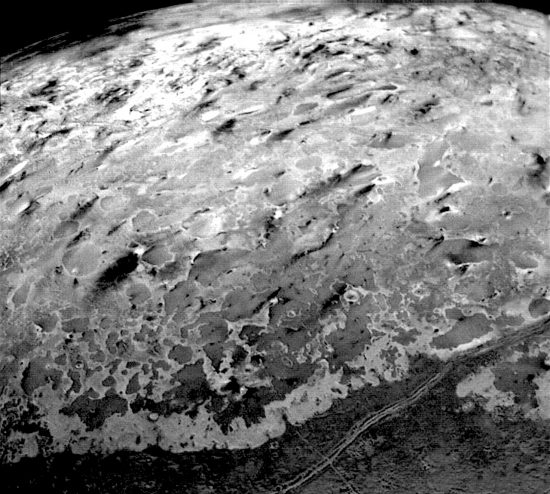
The surface of Triton showing black streaks. Credit: NASA/JPL.
Sep 29, 2017
A captured moon?
Neptune’s moons do not fit into an orderly arrangement. Nereid’s orbit takes it so far out at perihelion that it almost escapes Neptune’s gravity. Most of Neptune’s moons are not visible from Earth and there is little known about them. About half are so close to Neptune that telescopes are not able to resolve them against the planet’s background.
Triton is the largest moon in the Solar System with a retrograde orbit that also exhibits signs of decay—it will probably crash into Neptune at some time in the future. Since the Nebular Hypothesis does not allow a retrograde moon to develop around a planet, it is probable that it formed elsewhere and was then captured.
Triton is a strange object. Like Saturn’s moon, Titan and Jupiter’s moon, Io, it possesses a cold, thin atmosphere, only 0.00001 that of Earth, at -235 Celsius. As mentioned, its retrograde orbit indicates that it is an unusually large captured object, two-thirds the size of Earth’s Moon. Its low temperature makes it the coldest moon in the Solar System, although Voyager 2 saw geyser-like formations shooting nitrogen gas and dust particles eight kilometers into space when it flew by Triton in August 1989. Mission specialists referred to them as “ice volcanoes” located in Triton’s south polar region.
Neptune is now officially recognized as the most distant planet, since Pluto was downgraded to dwarf planet status. Triton accompanies Neptune in an elliptical orbit around the Sun at an average distance of about 4,495,060,000 kilometers, taking 165 Earth years to complete an orbit. Putting the distance in perspective, the last time Neptune was in the same orbital position as it is now was nine years before the beginning of the American Civil War. Since Triton changes seasons only once every forty years, it is the first time in over a century that Summer has come.
Triton’s surface looks a lot like Ariel, one of the moons circling Uranus; or Enceladus, one of Saturn’s moons. There are similarities with Jupiter’s moons Europa, Ganymede, and Io, as well. Polar ice caps similar to those on Mars are also visible.
The so-called “geysers” on Triton lead planetary scientists to speculate that there is a sub-surface ocean. Jupiter’s moon Europa is also said to harbor an ocean of water beneath its icy crust, along with Ganymede and Callisto. Saturn’s moon Enceladus is thought to eject hot water from cracks in its south pole, while Titan exhibits what conventional scientists say are lakes of ethane on the surface, but an ocean beneath its frigid crust. Even Pluto might have liquid water under layers of frozen gases. Each case was discussed in previous Pictures of the Day, leading to the conclusion that it is electrical effects that are causing the putative eruptions of vapor from those objects.
Geysers, darkened cavities, and “wind streaks” on Triton were explained as electric discharge effects in other locations. A previous Picture of the Day noted that the “Dalmatian spots” on Mars were created by charged particle beams excavating ice, provoking massive geyser activity. Instead of solar heating, perhaps Triton’s orientation within the electric fields generated by Neptune should be considered.
Astronomers ignore electricity when analyzing Neptune’s frigid vicinity. They do not consider that similar formations on Io, Enceladus, or Mars are relevant to conditions on Triton. The differences between them are not an issue when an electrical interpretation is considered. During an August 2008 flyby, for example, the now defunct Cassini orbiter’s plasma sensors found variable ion and electron beams propagating from Saturn’s northern hemisphere. That was something of a puzzle, until the time-variable emissions from Enceladus’ south polar vents were found to correspond with brightness variations in Saturn’s aurora. A similar condition probably exists between Neptune and Triton. Future missions will most likely confirm the Electric Universe viewpoint.
Stephen Smith












